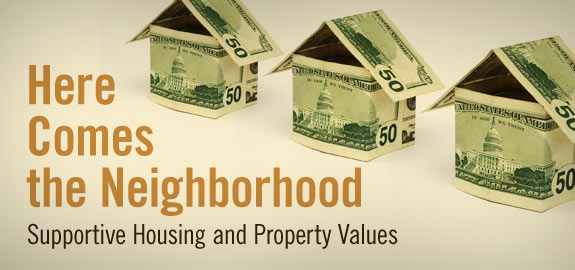Proposals for new supportive housing developments often face opposition from community members concerned about property values. Yet, recent research findings suggest there is little evidence to support fears that supportive housing will negatively impact surrounding property values. This article shares highlights from this research reported by New York University’s Furman Center for Real Estate and Urban Policy.
Proposals for supportive housing developments often face opposition from community members concerned about property values. Many proposals are rejected due to public outcry. This can create a substantial roadblock to expanding supportive housing across the nation. Unfortunately, there exists a pervasive stigma against people who are homeless.
How can supportive housing programs overcome this stigma?
One way is to share the benefits of supportive housing with the community. Supportive housing offers a foundation for someone who is homeless – a place to call home. A team of caseworkers, clinicians, and other homeless service providers create a network of compassion for the individual.
Supportive housing programs offer a chance for people to realize their potential and achieve their dreams. With a stable foundation, these individuals are often able to resume working and to move forward in their lives.
Yet, the challenge is not to show the benefits to individuals who would enroll. Rather, we need to show the benefit to those who voice opposition.
Rigorous research is a powerful way to make the case for the benefits of supportive housing in our communities. New York University’s Furman Center for Real Estate and Urban Policy recently published a policy brief studying the impact of supportive housing on surrounding neighborhoods in New York City.
The report seeks to determine whether supportive housing units have an effect on property values in neighboring homes and buildings. It included supportive housing units, defined as “a type of affordable housing that provides on-site services to people who may need support to live independently.” The NYU research team surveyed 7,500 supportive housing units in New York City, using data from 1974 to 2005 and analyzing the trends of property values within 500 to 1500 feet of the units.
The results are clear: there is little evidence to support the fear that supportive housing will negatively impact surrounding property values. Researchers concluded that “a supportive housing development does not have a statistically significant impact on the value of properties within 500 feet of the development.” Further, the report found that once construction was completed on a supportive housing project, the value of properties located within 500 feet of the supportive housing actually increased relative to other properties in the neighborhood.
In addition to providing a foundation for individuals, supportive housing benefits their families and friends, which benefits the entire community. Carol Wilkins, Director of Intergovernmental Policy for the Corporation of Supportive Housing comments, “Our communities are better off with 30% fewer chronically homeless living on the street.”
Supportive housing is especially stabilizing for homeless families, according to Wilkins. “What strikes me with regards to positive impacts of supportive housing is also that…parents [that move into supportive housing] have been able to reestablish a supportive relationship [with their kids] in a way they couldn’t have when they were on the streets.”
Supportive housing programs benefit overall community health. Studies show that supportive housing helps communities to save money. It cuts down on emergency room visits, hospitalizations, arrests, and other high cost services incurred by people struggling to live on the streets without any supports.
Supportive housing helps stabilize both the individual and our communities. Often, in order to change the life of one person, we have to change the minds of many. This may be a pothole-laden road, but it is one worth fixing.
Interview with Carol Wilkins conducted by Livia Davis, MSW of the Center for Social Innovation.
Click here to read the full policy brief “The Impact of Supportive Housing on Surrounding Neighborhoods: Evidence from New York City” by the Furman Center.

